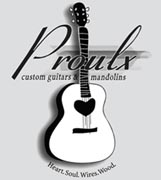|
Click
On Any Image To View Full Size
| |
|
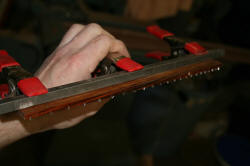
The Stainless steel frets have all been pressed in place, and carefully
leveled. I'll now clamp this steel tube to the back of the fretboard to
keep it straight, and...
|
|
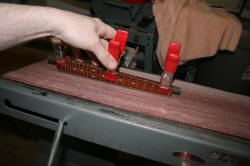
..head to the long bed sander to grind off the ends, and begin the
bevel. This is part of why SS frets don't present a problem for me; time
for the big tools <lol> In actual use, when my right hand isn't holding
a camera, I have two hands holding and guiding the fretboard.... |
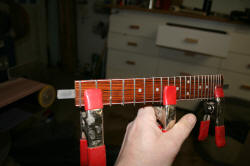
Here we are! It does take some practice to not grind up the fretboard,
also; been there, ruined that. The "trick" is to remember that there is
more steel at one end than at the other, and apply pressure accordingly. |
|
|
|
|
|
|
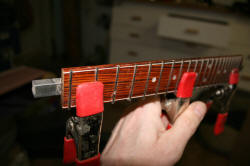 |
|
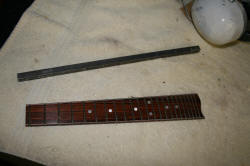
All done. I'll refine the bevel twice; first with a 6" file once it's
attached to the neck, and again with a tiny, fine file at the final
setup. But the big sander got us here quickly, and without any effort. |
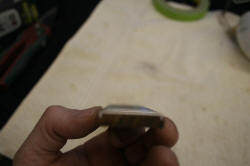
Oh, and yes, the frets are very level, even at this time. |
|
|
|
| |
|
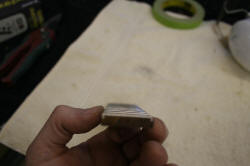 |
|
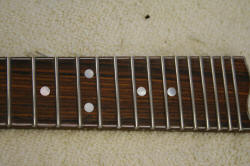 |

Here's the 6" file I'll use on the ends tomorrow. |
|
|
|
|
|
|
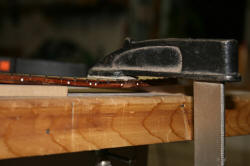
After fretting, the fretboard does acquire an induced arch, due to the
fret tangs pressed tightly in the slots. I'll counter this by reverse
pressing the fretboard, at first the whole length, then on to sections,
until I have a board that will lay dead flat on a cast iron slab. It's
trial and error, but it's intuitive and really doesn't take much effort.
As a bonus, the fret's tangs are driven into the side of their slots
even more tightly! |
|
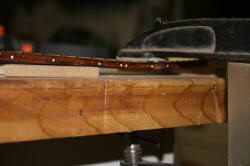
This, to me, is the advantage to fretting before installing the
fretboard. This gives me complete control over the entire process, as I
can "work" each item separately to perfection, and -then- assemble the
whole. The other way is to fret after attaching the fretboard, where we
plane the fretboard flat after gluing, then tap-in the frets. While this
is a proven method, I don't like that I can't work the fretboard
independently; the fret tangs will cause a slight bow, and we need to
carefully compensate for it, and that involves a good bit of guesswork
and experience, but some boards will always react differently to
fretting. Thus, we see 2 way truss rods gaining popularity. I'd rather
build a neck system that is level, and will remain such. Besides, I
can't bring myself to hammering-in frets on a new instrument <lol> Both
methods work, but the above is the one I choose, and now you know why. |
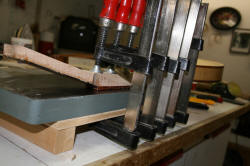
Once I'm happy with the board,. and it stays flat for a day or more,
I'll glue it to the neck, which has also been checked for flatness. When
all is said and done, we'll have a very flat,. level playing surface. My
solid rod in the neck is so stiff that this neck will remain flat for
its entire life. My measured relief, now that the mandolin is strung,
came in at .003". |
|
|
|
| |
|
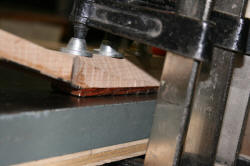
A cast iron plate, which has been checked for flatness, is the "caul"
behind the frets for this one, as this is a flat fretboard. For the
radiused boards, I have a machined aluminum caul which will sit atop the
cast iron plate. |
|
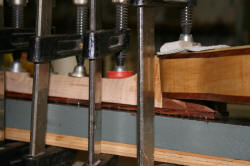
A lot of clamps, each applying just a bit of force, is key. I've long
used epoxies for this joint, because it contains no water, and won't
induce a bow to the neck. The epoxy I use has been tested and does
release at the same temperature ranges as wood glues, so it is
reversible. That said, I used hot hide glue on our A-5 here; I hadn't
used HHG in a while for this joint, and decided to try it again, now
that I have all these heavy duty plates and all. Sure enough, it worked
like a charm! No bow at all. So long, epoxy... |
..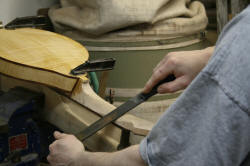
We can now begin carving the neck! I use various rasps, files, scrapers
and a sanding block or two. I rather enjoy this task, really! |
|
|
|
|
|
|
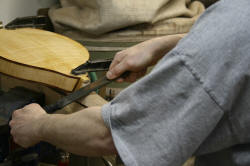 |
|
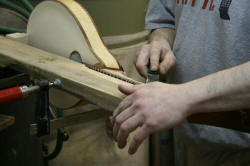 |
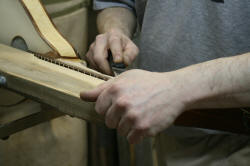 |
|
|
|
| |
|
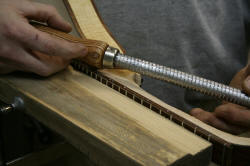
These jobbies are great! I forget what they're called at this moment,
but if you need to know, e-mail me.... |
|
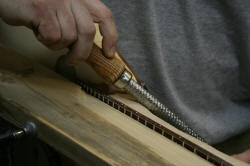 |
Neck carving is continued on the next
page! |
|
|
|
|
|
|
|
|
|
|
|
|
|
This A-52 model is being donated to the Studdard Family Scholarship Fund,
and it will be drawn on June 26th, 2009 at Steve Kaufman's Acoustic Kamp. If
you would like to purchase a chance(ticket), or to simply donate something
toward the fund, please contact Warren
Knorr or
call JoEllen at Steve's
Flatpik Central Ph 865 982 3808 Mon-Fri 9AM to 2PM EST Each $10(Ten Dollar)
donation buys one chance/ticket!
PREVIOUS PAGE
NEXT
PAGE
|
